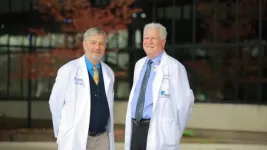(Press-News.org) CHAMPAIGN, Ill. -- Agricultural scientists who study climate change often focus on how increasing atmospheric carbon dioxide levels will affect crop yields. But rising temperatures are likely to complicate the picture, researchers report in a new review of the topic.
Published in the Journal of Experimental Botany, the review explores how higher temperatures influence plant growth and viability despite the greater availability of atmospheric CO2, a key component of photosynthesis.
Excessive heat can reduce the efficiency of enzymes that drive photosynthesis and can hinder plants' ability to regulate CO2 uptake and water loss, the researchers write. Structural features can make plants more - or less - susceptible to heat stress. Ecosystem attributes - such as the size and density of plants, the arrangement of leaves on plants or local atmospheric conditions - also influence how heat will affect crop yields.
The review describes the latest scientific efforts to address these challenges.
"It's important to have an understanding of these issues across scales - from the biochemistry of individual leaves to ecosystem-level influences - in order to really tackle these problems in an informed way," said lead author Caitlin Moore, a research fellow at the University of Western Australia and an affiliate research fellow at the Institute for Sustainability, Energy, and Environment at the University of Illinois Urbana-Champaign. Moore led the review with Amanda Cavanagh, another U. of I. alumna now at the University of Essex in the U.K.
"Historically, there's been a lot of focus on rising CO2 and the impact that it has on plants," said co-author Carl Bernacchi, a professor of plant biology and of crop sciences and an affiliate of the Carl R. Woese Institute for Genomic Biology at the U. of I. "And it is an important factor, because we are changing that carbon dioxide concentration enormously. But it's a small part of the bigger story. Once you throw changing temperatures into the mix, it completely messes up our understanding of how plants are going to respond."
"Take Rubisco, the key enzyme that fixes carbon dioxide into sugars, making life on Earth possible," Cavanagh said. "Rubisco speeds up as the temperature increases, but it's also prone to making mistakes."
Instead of fixing carbon dioxide by binding it to sugars, a key step in photosynthesis, Rubisco sometimes fixes oxygen, initiating a different pathway that wastes a plant's resources. Higher temperatures make this more likely, Cavanagh said. At even higher temperatures, the enzyme will begin to lose its structural integrity, making it ineffective.
Excessive heat can also undermine a plant's reproductive output. Other heat-sensitive enzymes are essential to the light-harvesting machinery of plants or play a role in moving sugars to different plant tissues, allowing the plant to grow and produce grains or fruits.
"If these little molecular machines are pushed out of the temperature range that's optimal, then they can't do their job," Cavanagh said.
When temperatures rise too high, plant leaves open the pores on their surfaces, called stomata, to cool themselves. Stomata also allow plants to absorb carbon dioxide from the atmosphere, but when they're fully open, the leaf can lose too much moisture.
"Temperature affects the atmosphere above the plant," Moore said. "As the atmosphere heats up, it can hold additional water, so it's pulling more water from the plants."
Scientists at Illinois and elsewhere are looking for ways to enhance crop plants' resilience in the face of these changes. Moore, whose work focuses on ecosystem-scale factors, said new tools that can help screen plants on a large scale are essential to that effort. For example, satellites that can detect changes in chlorophyll fluorescence in plants can indicate whether a crop is under heat stress. These changes in fluorescence are detectable before the plant shows any outward sign of heat stress - such as their leaves turning brown. Developing these tools may enable farmers to respond more quickly to crop stress before too much damage is done.
Cavanagh, who studies the molecular biology and physiology of plants, said some plants are more heat tolerant than others, and scientists are searching their genomes for clues to their success.
"For example, you can look at wild Australian relatives of rice that are growing in much harsher climates than most paddy rices," she said. "And you see that their enzymes are primed to work more efficiently at hotter temperatures."
One goal is to transfer heat-tolerant genes to cultivated rice varieties that are more susceptible to heat stress.
Other strategies include engineering structures that pump more CO2 to the site of carbon fixation to improve Rubisco efficiency; altering the light-gathering properties of leaves at the tops and bottoms of plants to even out distribution of sunlight and maintain moisture levels; and changing the density of stomata to improve their control of CO2 influx and moisture loss.
Collaboration between scientists focused on different scales of ecosystem and plant function - from the atmospheric to the molecular - is essential to the success of efforts to build resilience in crop plants, the researchers said.
"The world is getting hotter at a shocking rate," Cavanagh said. "And we know from global models that each increase in gross temperature degree Celsius can cause 3% to 7% losses in yield of our four main crops. So, it's not something we can ignore.
"What makes me optimistic is the realization that so much work is going into globally solving this problem," she said.
INFORMATION:
Cavanagh and Bernacchi are affiliates of the Realizing Increased Photosynthetic Efficiency project at the U. of I. Moore also is an affiliate of the Center for Advanced Bioenergy and Bioproducts Innovation at Illinois. Bernacchi is a research plant physiologist for the U.S. Department of Agriculture, Agricultural Research Service.
To reach Carl Bernacchi, email bernacch@illinois.edubernacch@illinois.edu.
To reach Amanda Cavanagh, email a.cavanagh@essex.ac.uk.
To reach Caitlin Moore, email caitlin.moore@uwa.edu.au.
The paper "The effect of increasing temperature on crop photosynthesis: From enzymes to ecosystems" is available online and from the U. of I. News Bureau.
The symptoms of postural orthostatic tachycardia syndrome, or POTS, can be as varied as they are confounding.
There can be fatigue, pain, bleeding disorders and anxiety. Heart palpitations and lightheadedness are common. Some patients experience gastrointestinal issues or brain fog. For the most severely affected, the simple act of standing up can send them crumpling into unconsciousness.
Though likely much more common than once thought, POTS remains something of a mystery. Many physicians have never heard of it. There's no lab test to confirm a diagnosis and no treatment to cure the condition.
That could all be ...
The hummingbird is named after its pleasant humming sound when it hovers in front of flowers to feed. But only now has it become clear how the wing generates the hummingbird's namesake sound when it is beating rapidly at 40 beats per second. Researchers from Eindhoven University of Technology, Sorama, a TU/e spin-off company, and Stanford University meticulously observed hummingbirds using 12 high-speed cameras, 6 pressure plates and 2176 microphones. They discovered that the soft and complex feathered wings of hummingbirds generate sound in a fashion ...
Tsukuba, Japan - Fungi are a vital part of nature's recycling system of decay and decomposition. Filamentous fungi spread over and penetrate surfaces by extending fine threads known as hyphae.
Fungi that cause disease within living organisms can penetrate the spaces between tightly connected plant or animal cells, but how their hyphae do this, and why the hyphae of other fungal species do not, has been unclear.
Now, a team led by Professor Norio Takeshita at University of Tsukuba, with collaborators at Nagoya University and in Mexico, has discovered a key feature that helps explain the differences among species. They compared seven fungi from different taxonomic groups, including some ...
Washington, D.C. - March 16, 2021 - For the first time, researchers have isolated the fungus Candida auris from a sandy beach and tidal swamp in a remote coastal wetland ecosystem. The discovery, reported this week in mBio, an open-access journal of the American Society for Microbiology, represents the first evidence that the pathogen thrives in a natural environment and is not limited to mammalian hosts. C. auris can cause infections resistant to major antifungal drugs, and since its identification in clinical patients 10 years ago scientists have sought to understand its origins.
A ...
SLOW walkers are almost four times more likely to die from COVID-19, and have over twice the risk of contracting a severe version of the virus, according to a team of researchers from the National Institute for Health Research (NIHR) Leicester Biomedical Research Centre led by Professor Tom Yates at the University of Leicester.
The study of 412,596 middle-aged UK Biobank participants examined the relative association of body mass index (BMI) and self-reported walking pace with the risk of contracting severe COVID-19 and COVID-19 mortality.
The analysis found slow walkers of a normal weight to be almost 2.5 times more likely to develop severe COVID-19 and 3.75 times more likely to die from the virus ...
Boston, Mass. - Just one year after the World Health Organization declared the novel coronavirus a global pandemic, three COVID-19 vaccines are available in the United States, and more than 2 million Americans are receiving shots each day. Americans are eager to get back to business as usual, but experts caution that opening the economy prematurely could allow a potential resurgence of the virus. How foot traffic patterns in restaurants and bars, schools and universities, nail salons and barbershops affect the risk of transmission has been largely unknown.
In an article published ...
LA JOLLA, CALIF. - March 16, 2021 - A Nature study authored by scientists at Sanford Burnham Prebys Medical Discovery Institute and the University of Hong Kong shows that the leprosy drug clofazimine, which is FDA approved and on the World Health Organization's List of Essential Medicines, exhibits potent antiviral activities against SARS-CoV-2 and prevents the exaggerated inflammatory response associated with severe COVID-19. Based on these findings, a Phase 2 study evaluating clofazimine as an at-home treatment for COVID-19 could begin immediately.
"Clofazimine is an ideal candidate for a COVID-19 treatment. It is safe, affordable, easy to make, taken as a pill and can be made globally available," ...
A study by Queen Mary University of London researchers, funded by Cancer Research UK, confirms the role of the oestrogen receptor biomarker in ductal carcinoma in situ and presents a new and more accurate method to predict long term outcomes for this pre-invasive stage of breast cancer. The study is published in Clinical Cancer Research.
Oestrogen receptor (ER), a protein expressed in some breast cancer cells, is routinely tested in invasive breast cancer to predict long-term outcomes select treatment options. Its role in ductal carcinoma in situ (DCIS) has been previously unclear, and it is not generally evaluated in this pre-invasive stage of breast cancer. The new research confirms the role of ER in predicting ...
A new study in Nicotine & Tobacco Research, published by Oxford University Press, finds that the use of high-strength nicotine e-cigarettes can help adults with schizophrenia spectrum disorders quit smoking.
Some 60-90% of people with schizophrenia smoke cigarettes, compared to 15-24% of the general population. The researchers from the University of Catania, in collaboration with colleagues from City University of New York and Weill Medical College of Cornell University, have assessed here the feasibility of using a high-strength nicotine e-cigarette to modify smoking behavior in people with schizophrenia spectrum disorders who smoke cigarettes. In this study ...
Finding the best materials for tomorrow's electronics is the goal of Professor Emanuele Orgiu of the Institut national de la recherche scientifique (INRS). Among the materials in which Professor Orgiu is interested, some are made of molecules that can conduct electricity. He has demonstrated the role played by molecular vibrations on electron conductivity on crystals of such materials. This finding is important for applications of these molecular materials in electronics, energy and information storage. The study, conducted in collaboration with a team from the INRS and the ...






